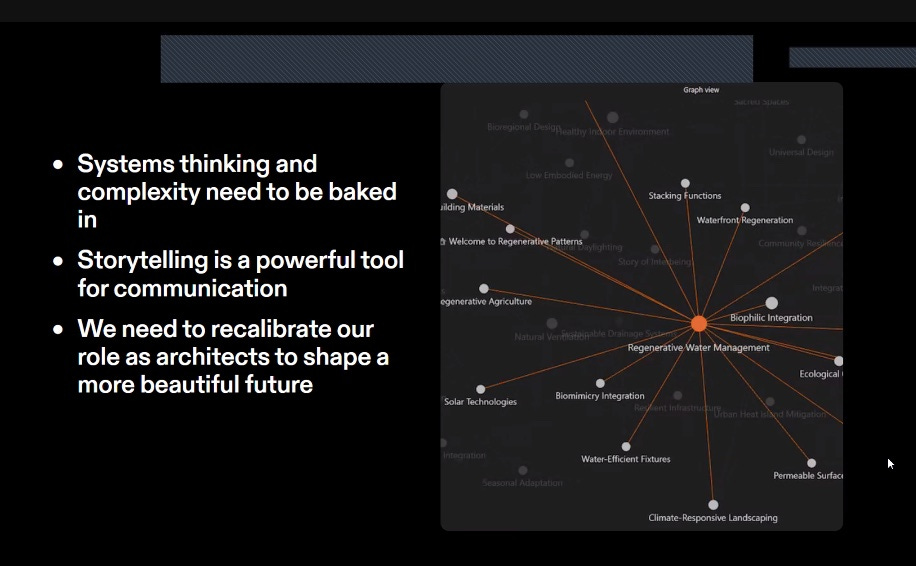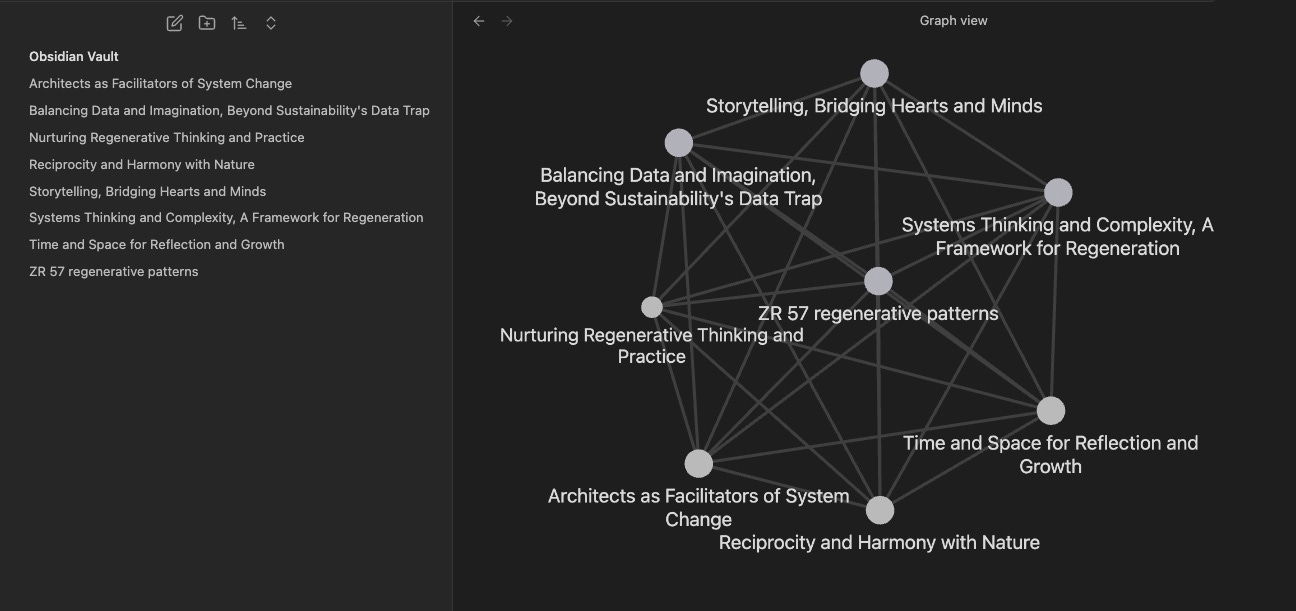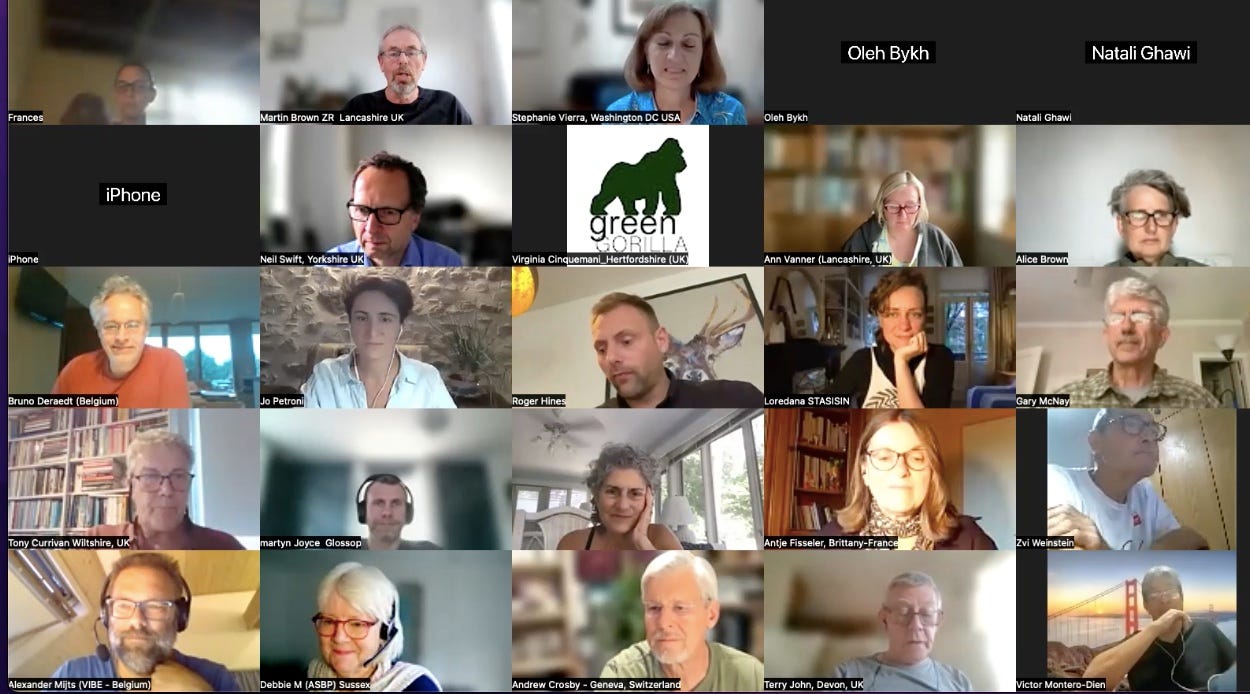“How many of you came into this (built environment) industry saying hey I’d love to become responsible for 40% of the world’s carbon emissions?
None of us and we’re sort of stuck. And it’s not working, which leads to a most important question … how do we get ourselves out of this mess?” Jo Petroni ZR57
Welcome, and thank you for reading Regen Notes.
Zoom Regenerative1 57 welcomed Jo Petroni, architect, masterplanner and sustainability/regenerative architecture consultant, sharing insights from her work and journey within the regenerative space.
How do we take Regenerative Architecture from fringe to mainstream?
Jo’s introduction gave context to her prompt for conversation. From working with her father, her disenchantment with conventional architecture led to the discovery of permaculture, the founding of Permarchitecture, and her work in bioclimatic design and natural building consulting. The discovery of systems thinking from A Pattern Language and The Carbon Almanac has led to exploring Regenerative Patterns, mostly recently at the Klosters Forum.
Jo’s prompt set the scene for a beautiful and insightful conversation on what it would take to flip our sector into regenerative thinking and practice, and what it takes to move us on that journey.
A Weaving Discourse
If it were possible to summarise the conversation - it could look like the following - however, to pull out headlines from a beautiful, flowing conversation that weaved so many regenerative thoughts into bullet points doesn't even start to do it justice and I am fully aware that others present will take away equally as powerful and insightful headlines.
regeneratively addressing the current climate challenges we face.
integrating systems thinking and complexity into regenerative architecture
emphasise the power of storytelling for effective communication. “Stories connect through feelings, the right data adds depth”
challenge the over-reliance on data in the sustainability movement and advocates for co-creation, imagination, and engagement with nature.
explore the role of architects as facilitators for system change and the importance of designing buildings in reciprocity and harmony with nature.
enable time and space for reflection, individual development and reasoning and
hold this regenerative space alive for those who are transitioning into regenerative thinking and practice.
From these headlines, we can use AI to see and illustrate patterns (one advantage of AI is its ability to identify patterns from text and audio far faster than we can) … There is an AI-generated short description in footnotes.2
A Regenerative Call to Action
“there is a field between right and wrong - I will meet you there” Rumi
This conversation continues and emerges across many regenerative networks and spaces - through Jo’s Regenerative Pattern work, through her highly recommended Epistolary substack, here on Regen Notes and a topic we will return to future Zoom Regenerative later this year.
“a global conscious collective that, like a forest web of life, reciprocates and invigorates, nurtures and heals, cross-pollinating regenerative practices for a healthy, thriving future” … An initial vision for Zoom Regenerative.
In support of this we invite your comments, links and feedback in shaping regenerative patterns. Leave comments here on Regen Notes or share thoughts on this substack Notes thread, or connect and discuss over on linkedin.
ZR 57 References
Jo's Epistolary Jo Petroni Substack
Christopher Alexander. Pattern Language
The Pattern Instinct by Jeremy Lent
Notes
Zoom Regenerative will take a break in August and return on September 19th. Subscribe to Regen Notes to ensure you get ZR updates
Below you can find a link to the video recording. Usually, the recordings from ZRs are not shared – long ago I concluded that the value of what we do on ZRs is in being there and being part of that conversation, at that time, with those in the conversation, not to passively absorb (without the context) at a later date. However, on this occasion, as the conversation was around increasing the scaling up of regenerative thinking and practice, full of so many golden threads, it feels right to share.
My gratitude to Jo for bringing this area of regenerative pattern thinking to the Zoom Regenerative space.
From zoom regenerative’s 2020 start, the underlying spirit has been to ‘celebreate’ the individual, to give voice to regenerative initaitives and to better understand how we are arriving into what we see as the regenerative thinking and practice space.
Regenerative Patterns from ZR 57
Systems Thinking and Complexity: A Framework for Regeneration Regenerative architecture embraces systems thinking and complexity theory as fundamental principles. By viewing buildings as integrated components within a larger ecosystem, architects uncover innovative ways to enhance sustainability. This holistic perspective ensures that every design decision is rooted in a deep understanding of interconnected relationships, enabling resilient solutions that stand the test of time.
Storytelling: Bridging Hearts and Minds The power of storytelling acts as a bridge between data and emotions. Effective communication is achieved when narratives are woven around sustainable concepts, infusing them with relatable human experiences. Stories touch hearts, and the judicious integration of data adds depth, substantiating the emotional connection with scientific rigor. This synergy captivates minds, encouraging collective action towards regenerative solutions.
Balancing Data and Imagination: Beyond Sustainability’s Data Trap. Regenerative architecture challenges the over-reliance on data by advocating co-creation and imagination. While data is essential, it should be interwoven with creative thinking to spark innovative design approaches. This shift acknowledges that sustainability is not solely quantitative; it flourishes through qualitative engagement with nature and imaginative problem-solving.
Architects as Facilitators of System Change. Architects transition from traditional roles to become facilitators of system change. Beyond design aesthetics, they guide projects towards regenerative outcomes by fostering collaboration, nurturing dialogue, and integrating diverse perspectives. As change agents, architects orchestrate harmonious relationships between people, spaces, and the environment, amplifying the regenerative potential of each structure.
Reciprocity and Harmony with Nature. Building as Ecosystems** Regenerative architecture embodies reciprocity and harmony with nature, emphasising that buildings are integral components of the ecosystem. Structures interact with their surroundings, utilizing renewable resources, minimizing waste, and enhancing biodiversity. This symbiotic relationship transcends a passive coexistence, nurturing a vibrant ecosystem that flourishes in tandem with human activities.
Time and Space for Reflection and Growth Regenerative architecture acknowledges the importance of reflection, individual development, and reasoning. Design spaces that provide respite and encourage contemplation, allowing occupants to reconnect with nature and develop a deeper understanding of their role within the larger system. These spaces become catalysts for personal growth and transformative thinking.
Nurturing Regenerative Thinking and Practice. Architects create environments that nurture regenerative thinking and practice. By integrating regenerative principles into everyday life, they sustain a living ecosystem of ideas, knowledge, and action. This continuity ensures that the transition to regenerative paradigms is supported and invigorated, inspiring a future where regenerative practices are the norm








Hi Polina - the link in the post leads you to the video. Can you clarify how you are looking to present the video ?
many thanks for reaching out,
Martin
I would be grateful if you share the video and give your permission to present it as tart of the conversation about green strategies of development of city architecture.